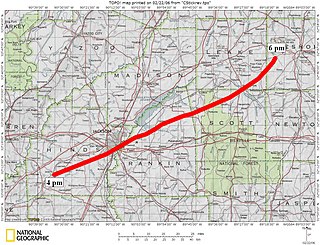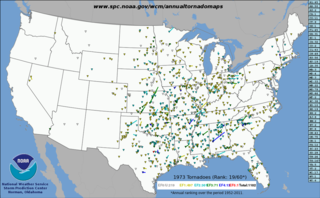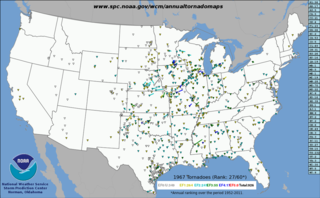
From April 2–3, 1956, a large, deadly tornado outbreak affected the Great Plains, parts of the South, and the upper Midwest in the contiguous United States, especially the Great Lakes region. The outbreak produced at least 55 tornadoes, including an F5 that devastated the Grand Rapids metropolitan area in the U.S. state of Michigan on April 3. It was one of three tornadoes to move across southwest Lower Michigan on that day. A fourth tornado struck north of the Manistee area, in the northern part of the peninsula. The Hudsonville–Standale tornado killed 18 and injured 333. It remains the fourth deadliest tornado on record in Michigan and is the most recent F5 on record there. Several other deadly, intense, long-tracked tornadoes also occurred during the outbreak. In addition to the fatalities in Kansas, Oklahoma, Michigan and Berlin, Wisconsin, three people were killed in Tennessee, one person in Kentucky and two more people in Wisconsin. In total, 39 were killed during the entire event.

A violent severe weather outbreak struck the Southeast on April 4–5, 1977. A total of 22 tornadoes touched down with the strongest ones occurring in Mississippi, Alabama, and Georgia. The strongest was a catastrophic F5 tornado that struck the northern Birmingham, Alabama, suburbs during the afternoon of Monday, April 4. In addition to this tornado, several other tornadoes were reported from the same system in the Midwest, Alabama, Georgia, Mississippi and North Carolina. One tornado in Floyd County, Georgia, killed one person, and another fatality was reported east of Birmingham in St. Clair County. In the end, the entire outbreak directly caused 24 deaths and 158 injuries. The storm system also caused the crash of Southern Airways Flight 242, which killed 72 and injured 22.

A destructive series of four tornadoes hit the Southeastern United States during March 3-4, 1966. The worst event was a violent and long-lived F5 tornado, dubbed the Candlestick Park tornado after the name of a recently opened Jackson, Mississippi shopping center that was leveled by the storm. The storm would bring catastrophic damage in Mississippi and Alabama along a 202.5-mile (325.9 km) track. The outbreak killed 58, injured 521, and caused $75.552 million in damage.
On April 21–24, 1968, a deadly tornado outbreak struck portions of the Midwestern United States, primarily along the Ohio River Valley. The worst tornado was an F5 that struck portions of Southeastern Ohio from Wheelersburg to Gallipolis, just north of the Ohio–Kentucky state line, killing seven people and injuring at least 93. Another long-tracked violent tornado killed six people, injured 364 others, and produced possible F5 damage as it tracked along the Ohio River. At least one other violent tornado caused an additional fatality and 33 injuries in Ohio. In the end, at least 26 tornadoes touched down, leaving 14 dead, including five in Kentucky and nine in Ohio.

On February 21–22, 1971, a devastating tornado outbreak, colloquially known as the Mississippi Delta outbreak, struck portions of the Lower Mississippi and Ohio River valleys in the Southern and Midwestern United States. The outbreak generated strong tornadoes from Texas to Ohio and North Carolina. The two-day severe weather episode produced at least 19 tornadoes, and probably several more, mostly brief events in rural areas; killed 123 people across three states; and wrecked entire communities in the state of Mississippi. The strongest tornado of the outbreak was an F5 that developed in Louisiana and crossed into Mississippi, killing 48 people, while the deadliest was an F4 that tracked across Mississippi and entered Tennessee, causing 58 fatalities in the former state. The former tornado remains the only F5 on record in Louisiana, while the latter is the deadliest on record in Mississippi since 1950. A deadly F4 also affected other parts of Mississippi, causing 13 more deaths. Other deadly tornadoes included a pair of F3s—one each in Mississippi and North Carolina, respectively—that collectively killed five people.
On June 3–4, 1958, a destructive tornado outbreak affected the Upper Midwestern United States. It was the deadliest tornado outbreak in the U.S. state of Wisconsin since records began in 1950. The outbreak, which initiated in Central Minnesota, killed at least 28 people, all of whom perished in Northwestern Wisconsin. The outbreak generated a long-lived tornado family that produced four intense tornadoes across the Eau Claire–Chippewa Falls metropolitan area, primarily along and near the Chippewa and Eau Claire rivers. The deadliest tornado of the outbreak was a destructive F5 that killed 21 people and injured 110 others in and near Colfax, Wisconsin.

This page documents notable tornadoes and tornado outbreaks worldwide in 1973, but mostly features events in the United States. According to tornado researcher Thomas P. Grazulis, documentation of tornadoes outside the United States was historically less exhaustive, owing to the lack of monitors in many nations and, in some cases, to internal political controls on public information. Most countries only recorded tornadoes that produced severe damage or loss of life. Consequently, available documentation in 1973 mainly covered the United States. On average, most recorded tornadoes, including the vast majority of significant—F2 or stronger—tornadoes, form in the U.S., although as many as 500 may take place internationally. Some locations, like Bangladesh, are as prone to violent tornadoes as the U.S., meaning F4 or greater events on the Fujita scale.

From April 2–3, 1982, a major tornado outbreak resulted in over 60 tornadoes and 30 fatalities, primarily over portions of Northeast Texas and Southwest Arkansas, as well as Southeastern Oklahoma. Three of the tornadoes were rated F4, and one officially was recorded as an F5 near Broken Bow, Oklahoma, all on April 2. Beginning on April 2, a series of tornado-producing supercells formed across portions of northeastern Texas and southeastern Oklahoma. One produced an F5 tornado, the first since April 4, 1977, which crossed mostly rural areas near Speer and Broken Bow, and deposited a motel sign from Broken Bow 30 miles (48 km) away in Arkansas. The F5 tornado resulted in no fatalities, but an F4 tornado in Paris, Texas, resulted in 10 fatalities and 170 injuries. Additionally, the Storm Prediction Center, known then as the Severe Local Storms Unit, issued its first officially documented high risk on April 2 as well as the first tornado watch to contain the wording Particularly Dangerous Situation (PDS).

This page documents the tornadoes and tornado outbreaks of 1967, primarily in the United States. Most tornadoes form in the U.S., although some events may take place internationally. Tornado statistics for older years like this often appear significantly lower than modern years due to fewer reports or confirmed tornadoes.

This page documents the tornadoes and tornado outbreaks of 1954, primarily in the United States. Most tornadoes form in the U.S., although some events may take place internationally. Tornado statistics for older years like this often appear significantly lower than modern years due to fewer reports or confirmed tornadoes.
This page documents the tornadoes and tornado outbreaks of 1951, primarily in the United States. Most tornadoes form in the U.S., although some events may take place internationally. Tornado statistics for older years like this often appear significantly lower than modern years due to fewer reports or confirmed tornadoes.
This page documents the tornadoes and tornado outbreaks of 1950, primarily in the United States. Most tornadoes form in the U.S., although some events may take place internationally.
A widespread, destructive, and deadly tornado outbreak sequence affected the Southeastern United States from April 28 to May 2, 1953, producing 24 tornadoes, including five violent F4 tornadoes. The deadliest event of the sequence was an F4 tornado family that ravaged Robins Air Force Base in Warner Robins, Georgia, on April 30, killing at least 18 people and injuring 300 or more others. On May 1, a pair of F4 tornadoes also struck Alabama, causing a combined nine deaths and 15 injuries. Additionally, another violent tornado struck rural Tennessee after midnight on May 2, killing four people and injuring eight. Additionally, two intense tornadoes impacted Greater San Antonio, Texas, on April 28, killing three people and injuring 20 altogether. In all, 36 people were killed, 361 others were injured, and total damages reached $26.713 million (1953 USD). There were additional casualties from non-tornadic events as well, including a washout which caused a train derailment that injured 10.

The first six days of December 1953 produced a destructive and deadly tornado outbreak sequence across the Southern United States. There were 19 confirmed tornadoes, including a violent F4 tornado that hit the northwest side of Alexandria, Louisiana and even more violent F5 tornado that hit Vicksburg, Mississippi. In all, the tornadoes killed 49 people, injured 404 others, and caused $45,709 million in damage. The death toll made this deadliest December tornado outbreak ever recorded and it would not be surpassed until 2021. This was also the last of the series of deadly and catastrophic tornado outbreaks to strike the US in 1953.

A deadly and destructive outbreak sequence of 23 tornadoes struck parts of the Great Plains and the Great Lakes in late-June 1957. At least seven significant tornadoes (F2+) touched down during the outbreak sequence. The most devastating storm was a large, violent, and catastrophic 500-yard-wide F5 tornado family that struck Fargo, North Dakota on Thursday, June 20, 1957, killing 10 people and becoming the deadliest tornado ever recorded in North Dakota. The outbreak caused 11 fatalities, 105 injuries, and $25.883 million in damage.
Five scattered tornadoes touched down across the Great Plains and Midwestern United States on June 19, 1951. The event was highlighted by a large, violent F4 tornado family that moved through the western and northern suburbs of Minneapolis, causing all the tornadic casualties from the outbreak. In all, one person was killed, 20 others were injured, and damage was estimated at $59 million. There was one additional death and six injuries from non-tornadic events as well.
Several destructive tornadoes struck the Southeastern United States, primarily along and east of the Lower Mississippi Valley, on February 13, 1952. Multiple intense tornadoes touched down throughout the day, three of which were killers. The deadliest and most destructive tornado of the outbreak was a violent F4 that touched down in south-central Tennessee, killing three people and injuring 44 others. A similarly destructive tornado—albeit of weaker, F2 intensity—formed from the same storm as the preceding F4 and became the second costliest of the outbreak. Another intense tornado affected the Mississippi embayment near Manila, Arkansas, injuring five people, and a pair of deadly F3s in Alabama claimed a combined two lives. In all, the outbreak killed five people and injured 102 others.

During the afternoon and evening of May 27, 1973, a violent and long-tracked tornado tracked across Central Alabama, where it produced catastrophic damage in the cities of Greensboro, Brent, Centreville, Montevallo, Columbiana, Wilsonville, and Childersburg. The tornado was on the ground for an exceptionally long time, crossing six counties along a track of 139.1 miles (223.9 km). During this long track, seven people were killed and 199 others were injured. The National Weather Service (NWS) rated the tornado F4 on the Fujita scale, with winds estimated to be between 210 and 261 mph. In the official publication for storm events in the United States, done in the months following a weather event, the National Oceanic and Atmospheric Administration and the National Climatic Data Center did not report any information for this tornado. The tornado also struck the NWS office in Centreville, becoming one of the few tornadoes to ever strike an NWS office building.

During the afternoon of May 11, 1999, a violent, multiple-vortex tornado struck areas around the community of Loyal Valley in Texas, killing one person. The tornado, rated a high-end F4 on the Fujita scale, caused extreme damage along its relatively short path. Meteorologist Bill Hecke of KNCT-FM stated the tornado's intensity rivaled the Bridge Creek–Moore F5 tornado, which had struck Oklahoma a week prior, and the 1997 Jarrell F5 tornado.
On December 18, 1957, a violent tornado struck north of Sunfield, Illinois, completely destroying structures in its path. The extreme damage led the National Weather Service to assign a rating of F5 on the Fujita scale.











